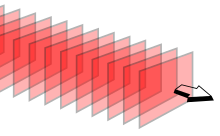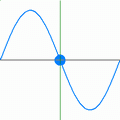Plane wave
A plane wave is a wave in three-dimensional space, the wave fronts (i.e. surfaces of equal phase angle ) of which are planes extended perpendicular to the direction of propagation . This means that the direction of propagation of the wave is spatially constant.
The term is used almost exclusively for waves that are also homogeneous and harmonious , i.e. H. which have a spatially constant amplitude and show a sinusoidal curve with a frequency that is constant over time . Such waves belong to the simplest solutions of the wave equation , which plays an important role in classical mechanics , electrodynamics and quantum mechanics .
Other solutions to the wave equation are the spherical wave ( concentric around a point) and the cylindrical wave (concentric around a straight line). These can be easily approximated in small areas far from the center using a flat wave.
The two-dimensional analog of the plane wave is a wave whose wave fronts are straight lines moving on a plane surface. A clear, but only approximately applicable example are the ocean waves approaching the beach.
Homogeneous harmonic plane wave
The picture on the right shows the local course of a harmonic plane wave that propagates in the x-direction and whose size A (x, t) oscillates in the y-direction (a snapshot at time t = 0 ). The maximum deflection ( amplitude ) of the wave is marked with , its wavelength with and its phase position at this point in time with . The wavelength indicates the periodicity of A in place.
The following image shows the course over time at a fixed location as an animation. The frequency is a measure of the periodicity of A in time. The phase velocity c indicates the ratio of the temporal period T and the spatial period :
- .
A plane wave is most easily described if the coordinate system is chosen so that one axis corresponds to its direction of propagation. No oscillation takes place in the directions perpendicular to the propagation. Thus, a harmonious homogeneous plane wave can be called
represent. In this case, the points of constant phase move with the phase velocity c in the positive x direction. In the inner brackets, the increase in x / c just compensates that of the time t , so that
represents a plane equation for the wavefront.
For a direction reversal, such as occurs due to reflection at an inhomogeneity in the medium (e.g. change in refractive index or characteristic acoustic impedance ), the sign of x or the x-axis itself must be reversed.
The physics of the periodically changing quantity A is unimportant for the concept of the plane wave. It can be a mechanical deflection , a change in pressure , a field strength or a probability amplitude . If it is a vector quantity, the direction of its amplitude indicates its polarization relative to the direction of propagation .
General shape of a plane wave
In general terms, a plane wave is given by
There is an arbitrary ( scalar or vector-valued ) function and . The wave propagates in the direction with the speed c . If the wave is observed at a fixed location , the observed variable changes over time according to the function , which does not necessarily have to be periodic. The points of the same oscillation phase form planes according to
The plane wave is a solution to the wave equation
In practice, only harmonic plane waves are used, since any general plane wave can be represented as the sum of harmonic plane waves. This is because the general shape of the plane wave A can be represented as a Fourier integral :
This corresponds to a sum over harmonic plane waves with frequency-dependent amplitudes . Here only the physically meaningful real part of the Fourier transformation is considered and represented in the last part of the equation using the identity with the complex conjugation *. Due to the validity of the superposition principle for the wave equation, only the spectral component of the angular frequency is sufficient for further considerations
consider. g is called the harmonic plane wave . Usually this form is expressed with the help of the wave vector . It applies and and thus
The real part of the harmonic plane wave corresponds for and to the sinusoidal plane wave introduced in the previous section.
Inhomogeneous plane wave
A plane wave is always a solution of the Helmholtz equation (temporal Fourier transformation of the wave equation)
with real dispersion relation . The Helmholtz equation is also solved if complex components are allowed for the wave vector :
So that the Helmholtz equation remains true, the wave number must remain real, which is due to the condition
and means a restriction on the choice of the complex wave vector. This condition clearly means that the real part ( ) of the wave vector must be perpendicular to its imaginary part ( ).
A wave of form
is called inhomogeneous plane wave or non-uniform plane wave . It propagates in that direction and its amplitude drops perpendicular to the direction of propagation. In contrast to the homogeneous plane wave , the planes of constant amplitude are perpendicular to the planes of constant phase. In addition, the phase velocity is always lower than with a homogeneous plane wave of the same frequency.
absorption
If the real and imaginary parts of the complex wave vector are selected as parallel vectors, the imaginary part of the wave number is not zero as in the previous section and the wave number becomes complex
is called the absorption coefficient or attenuation constant and referred to as the phase constant. This leads to a dampened harmonic plane wave. If one places the x-axis in the direction of propagation, it follows
The levels of constant phase and constant amplitude are identical, only the amplitude decreases exponentially in the direction of propagation. So it is a homogeneous plane wave.
idealization
A plane wave always fills an infinitely extended space and is therefore an idealization of the real wave. Because, on the one hand, a plane wave cannot be emitted by a finitely extended transmitter and, on the other hand, the energy of a plane wave is infinite. Both are unphysical.
annotation
- ↑ Water waves decrease (with constant frequency) their speed of propagation and wavelength, when the water depth decreases, and therefore change their usually non-sinusoidal shape up to the breaker.
See also
Web links
Individual evidence
- ↑ LM Brekhovskikh: Waves in Layered Media . In: Applied Mathematics and Mechanics . tape 16 . Academic Press, 1980.
- ^ GS Smith: An Introduction to Classical Electromagnetic Radiation . Cambridge University Press, 1993, pp. 179 ( limited preview in Google Book search).
- ↑ Inhomogeneous plane waves can change into simple plane waves and vice versa when they are refracted or reflected. But they only exist in limited spaces and not, like the simple plane wave, also in infinite spaces . The reason for this is as follows: The amplitude of the inhomogeneous plane wave decreases exponentially in one direction, but this is equivalent to an exponential increase in the opposite direction. This leads to an infinite power density in an unlimited space and is unphysical.
- ^ DG Durgin: Space-Time Wireless Channels . Prentice Hall Professional, 2003, pp. 78–79 ( limited preview in Google Book search).
- ↑ G. Lehner: Electromagnetic field theory . Springer, 2008, p. 436 ( limited preview in Google Book search).







































![A (x, t) = \ int _ {0} ^ {\ infty} \ phi (\ omega) \ exp \ left [i ({\ vec \ beta} {\ vec x} - \ omega t) - ({ \ vec \ alpha} {\ vec x}) \ right] {\ mathrm {d}} \ omega](https://wikimedia.org/api/rest_v1/media/math/render/svg/24c11a4ebcd97e97a9617705f7496406e596f3a0)




